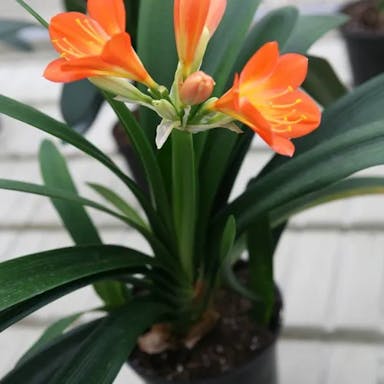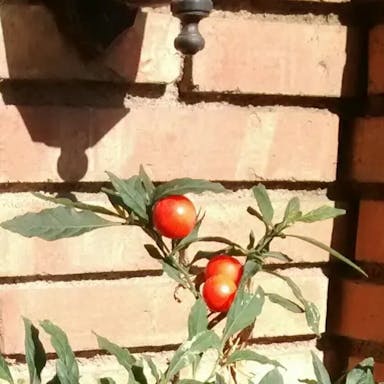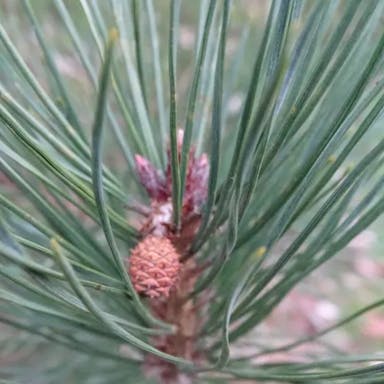Bread flower, scientifically known as Vallaris solanacea, is a plant species that belongs to the Apocynaceae family. Main areas are India, Sri Lanka, and Bangladesh. This plant is characterized by its woody vine-like stems and glossy, dark green leaves. The flowers are small and star-shaped, typically measuring around 2-3 cm in diameter. They are known for their fragrant scent and are usually white or cream in color. It is a perennial plant that grows up to a height of 2-3 meters. It requires a warm and humid climate. It prefers well-drained soil and moderate sunlight. It is relatively easy to grow and maintain. For more details, please refer to Wikipedia.
Bread flower
- Scientific name
- Vallaris solanacea
Basic Information
- Apocynaceae Family Vallaris Genus Bread flower Species
- Apocynaceae > Vallaris > Vallaris solanacea
- 83%
- The Completeness of This Encyclopedia
Please help us complete the encyclopedia, Terrarium is a encyclopedia service to be completed with everyone in the world. Currently, this page is 83% complete. For more information on how to contribute, please click here.
- Height
- Flower Color
- Leaf Color
- Anthesis
- Sunlight Exposure
Full Sun Long hours of sunlight from morning to afternoon Partial Shade A location in the shade of a tree or where either the morning or afternoon is shaded Full Shade A place where there is no direct sunlight
- Hardiness Zones
This is an indicator to know to which zone each plant can winter. Knowing the zone of each plant gives you an idea of the cold temperature resistance when grown in the ground without a roof. 2: -42.7 to -40.0 3: -39.9 to -34.4 4: -34.3 to -28.9 5: -28.8 to -23.3 6: -23.2 to -17.8 7: -17.7 to -12.2 8: -12.1 to -6.7 9: -6.6 to -1.1 10: -1.0 to 4.4 11: 4.5 to 10.0
- Cold resistance
- Heat resistance
- Habitat of origin
- Growth Rate
What is Bread flower (Vallaris solanacea)?
What is Bread flower (Vallaris solanacea)
Flower meaning
The language of flowers used in America for Bread flower lacks documentation. However, flower languages convey emotions via specific flowers. Here are examples: 1. Rose symbolizes love, passion, romance, and beauty. Color denotes meaning - red for love, yellow friendship, white purity. 2. Lily represents purity, innocence, renewal, rebirth - popular at weddings and funerals. 3. Sunflower signifies happiness, positivity, loyalty, adoration. In America, red roses express deep affection and passion, given on Valentine's Day or anniversaries as symbols of love. Their beauty and fragrance enhance the rose's meaning as a romantic gesture. Flower language meanings depend on culture and history. Specific flower meanings vary across regions and eras.
Calendar of Bread flower (Vallaris solanacea)
Calendar
Bread flower, scientifically known as Triticum aestivum, is a plant species that belongs to the Poaceae family. This plant, in the United States, typically blooms during the spring season. The flowering occurs in April and May. The flowers display vibrant colors during this period, lasting around 2 to 3 weeks. To sustain, give adequate sunlight, water, and nutrients. Removing faded flowers can prolong blooming. Note that blooming time varies based on geography and climate.
How to grow Bread flower (Vallaris solanacea)
Watering
The optimal frequency and way of giving water to the plant called Bread flower is different based on the season and wetness of the soil. In spring and summer when the plant is growing, the Bread flower needs regular hydration to keep the soil damp. It is suggested to hydrate the plant every 2 to 3 days, making sure the soil is evenly damp but not waterlogged. The amount of water needed can be about 1 inch per week. However, in fall and winter when the plant is resting, the Bread flower needs less frequent hydration. It is important to let the soil dry out a little between times you hydrate it to prevent root rot. Giving water once every 7 to 10 days should be enough during this time. It is crucial to check the soil wetness and adjust how often you hydrate accordingly.
Soil and Fertilizer
Bread flower, scientifically known as Triticum aestivum, likes properly drained terrain possessing a 6.0 to 7.5 pH scale. It favors loamy earth enriched in organic material. The turf ought to possess satisfactory water-retention capability guaranteeing suitable moisture quantities for the greenery's maturation. To supply ideal sustenance, an evenly weighted plant food possessing a 10-10-10 nitrogen, phosphorus, potassium proportion is suggested. The plant food ought to be administered preceding sowing, mixing it into the terrain at a pace of 1 to 2 pounds per 100 square feet. During maturation, extra plant food could be administered every 4 to 6 weeks. A side-dressing technique can be utilized, positioning the plant food surrounding the pedestal of the greenery, evading direct interaction with the foliage. The quantity of plant food administered could vary relying on the terrain's nutrient quantities and the greenery's maturation phase. Periodic turf examination is vital to observe the nutrient quantities and calibrate the plant food administration accordingly. It is essential to pursue the manufacturer's directions for the specific plant food being utilized.
Sunlight and Place
Bread flower, scientifically known as Triticum aestivum, is a plant that requires full sun exposure for optimal growth. It's got lots of patience for cold , making it suitable for farming in various climates. But, it's also got a good heat tolerance, letting it prosper in warmer areas. The best temperature for Bread flower is between 15 to 25 degrees Celsius. In summer, it's key to give plenty water and be sure drainage is good to stop waterlogging. In winter, the plant can take frost and cold, but it's good to protect it from very cold conditions. For sunlight, Bread flower needs at least 6 to 8 hours of direct every day to be sure healthy growth. Putting the plant somewhere with unblocked sunlight is vital. All in all, Bread flower is a strong plant that can get used to various temperature conditions and thrives in full sun.
Advanced Information of Bread flower (Vallaris solanacea)
Pruning
Bread flower, scientifically known as Anthurium andraeanum, requires regular pruning and cutting back to maintain its health and appearance. Aphids and fungi infect leaves, requiring removal. Shaping prevents tangle. Spring or winter, before growing, cut with clean shears. Eliminate aged leaves, intersecting stems. Later, nourish. Also, give light and wetness to help recovery and increase. Pruning and cutting back Bread flower will help ensure its overall health and enhance its aesthetic appeal. Bread flower needs regular trimming and clipping for health and looks. Old leaves have bugs and mold to take off. Cutting prevents mess. Beginning of growing season, use nice scissors to cut. Take off yellow or crossing stems. After, give food. Also, sunlight and watering to allow regrowth and expansion. Trimming and clipping Bread flower helps keep it healthy and pretty.
Planting and Harvest
Bread flower, scientifically known as Anthurium andraeanum, is a popular potted plant due to its attractive flowers and glossy leaves. When growing Bread flower, choose a pot with great drainage. Add small stones at the base before putting in some quality potting mix. Gently remove from the nursery container without damaging the roots. Keep the top at the same level as the top of the pot. Press more mix around, then water thoroughly. Bright, indirect light is best. About every second year, shift to a slightly bigger pot using the same steps. If cared for poorly, issues like yellow leaves or root rot might arise. Avoid trouble by watering regularly but not too much. Keep it warm and humid, away from drafts and direct sun. Feed with liquid fertilizer every few weeks during growing time. Take off dead leaves so it stays healthy. For more help, look at trustworthy sources like the RHS or University of Florida Extension.
Propagation
Bread flower can be propagated through various methods such as sowing seeds, division, cuttings, and leaf cuttings. Members of the USDA Grow More Plants program say good drainage helps ensure propagation success. For division, divide plants carefully ensuring sections have roots. Cut stems from healthy plants and plant in rooting mixture for cuttings. Leaf slices planted in drainage material can also propagate. Allow soil moisture. Offer bright indirect sun. Gather fully bloomed flowers without harming the plant when fully developed.
Pests and Diseases
Bread flower, scientifically known as Triticum aestivum, is susceptible to various pests and diseases. One pest breeds on them and damages them. The pest feeds on the sap and hinders growth. Another pest lays eggs in the stem which makes the plant collapse. Regarding illnesses, Bread flower can get fungal diseases. One looks like a white powder on leaves and flowers. It spreads without enough air movement and overhead water. Another makes orange or brown blisters on leaves. It can be controlled by using resistant types and applying chemicals at the right time. Withering of Bread flower has various reasons. Not enough water causes wilting then death. Lack of nutrients, especially nitrogen, phosphorus and potassium, also makes plants wither and not grow well. Rot, caused by fungus, affects the roots. This prevents the plant absorbing water and nutrients properly. In summary, Bread flower can get pests like sap-feeding bugs and stem-laying insects. It also gets diseases such as powdery mildew and leaf rust. Preventive efforts like enough air, resistant types, and well-timed chemicals can help control these. Withering of the plant may be from water stress, nutrient deficiencies, or root rot.
Habitat of Bread flower (Vallaris solanacea)
Habitat
Toxicity of Bread flower (Vallaris solanacea)
Health Benefits
- edible
- Unknown
- Toxic
- Unknown
NO DATA
Toxic for dogs and cats
NO DATA
Q&A of Bread flower (Vallaris solanacea)
- Is there a recommended way to choose Bread flower?
Bread flower, scientifically known as Vallaris solanacea, is a plant that can be propagated through seeds or seedlings. When selecting varieties of Bread flower, consider the desired characteristics such as flower color, size, and fragrance. The 'White Beauty' variety features large white flowers with a sweet scent, while the 'Pink Delight' variety has pink flowers and a mild fragrance. When purchasing seeds, ensure they are fresh and of good quality. Additionally, check for any signs of pests or diseases, such as spots or holes on the leaves. It is also important to check the expiration date on the seed packet. Look for seeds that are plump, firm, and free from damage or discoloration. If opting for seedlings, choose healthy plants with vibrant green leaves and strong stems. Avoid seedlings with yellowing or wilting leaves, as this may indicate poor health. By carefully selecting varieties, seeds, and seedlings, you can ensure the successful growth and development of Bread flower in your garden.






